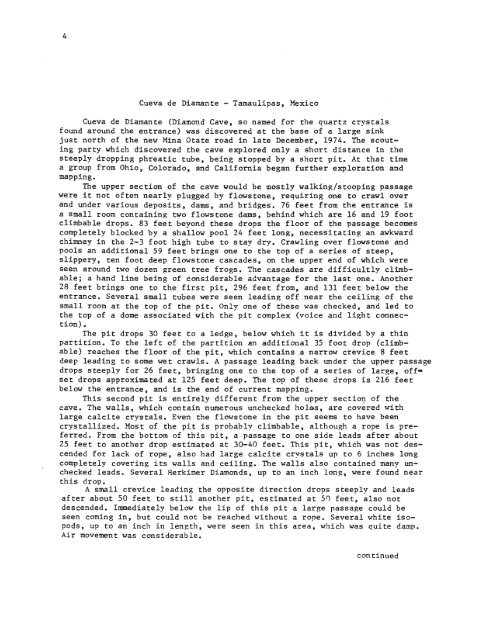asscciation for mexican cave studies box 7672 ut station austin ...
asscciation for mexican cave studies box 7672 ut station austin ...
asscciation for mexican cave studies box 7672 ut station austin ...
- No tags were found...
Create successful ePaper yourself
Turn your PDF publications into a flip-book with our unique Google optimized e-Paper software.
4Cueva de Diamante -Tamaulipas, MexicoCueva de Diamante (Diamond Cave, so named <strong>for</strong> the quartz crystalsfound around the entrance) was discovered at the base of a large sinkjust north of the new Mina Otate road in late December, 1974. The sco<strong>ut</strong>ingparty which discovered the <strong>cave</strong> explored only a short distance in thesteeply dropping phreatic tube, being stopped by a short pit. At that timea group from Ohio, Colorado, and Cali<strong>for</strong>nia began further exploration andmapping.The upper section of the <strong>cave</strong> would be mostly walking/stooping passagewere it not often nearly plugged by flowstone, requiring one to crawl overand under various deposits, dams, and bridges. 76 feet from the entrance isa small room containing two flowstone dams, behind which are 16 and 19 footclimbable drops. 83 feet beyond these drops the floor of the passage becomescompletely blocked by a shallow pool 24 feet long, necessitating an awkwardchimney in the 2-3 foot high tube to stay dry. Crawling over flows tone andpools an additional 59 feet brings one to the top of a series of steep,slippery, ten foot deep flowstone cascades, on the upper end of which wereseen around two dozen green tree frogs. The cascades are difficultly climbable;a hand line being of considerable advantage <strong>for</strong> the last one. Another28 feet brings one to the first pit, 296 feet from, and 131 feet below theentrance. Several small tubes were seen leading off near the ceiling of thesmall room at the top of the pit. Only one of these was checked, and led tothe top of a dome associated with the pit complex (voice and light connection).The pit drops 30 feet to a ledge, below which it is divided by a thinpartition. To the left of the partition an additional 35 foot drop (climbable)reaches the floor of the pit, which contains a narrow crevice 8 feetdeep leading to some wet crawls. A passage leading back under the upper passagedrops steeply <strong>for</strong> 26 feet, bringing one to the top of a series of large, offsetdrops approximated at 125 feet deep. The top of these drops is 216 feetbelow the entrance, and is the end of current mapping.This second pit is entirely different from the upper sectio~ of the<strong>cave</strong>. The walls, which contain numerous unchecked holes, are covered withlarge calcite crystals. Even the flowstone in the pit seems to have beencrystallized. Most of the pit is probably climbable, although a rope is preferred.From the bottom of this pit, a passage to one side leads after abo<strong>ut</strong>25 feet to another drop estimated at 30-40 feet. This pit, which was not descended<strong>for</strong> lack of rope, also had large calcite crystals up to 6 inches longcompletely covering its walls and ceiling. The walls also contained many uncheckedleads. Several Herkimer Diamonds, up to an inch long, were found nearthis drop.A small crevice leading the opposite direction drops steeply and leadsafter abo<strong>ut</strong> 50 feet to still another pit, estimated at 50 feet, also notdescended. Immediately below the lip of this pit a large passage could beseen coming in, b<strong>ut</strong> could not be reached witho<strong>ut</strong> a rope. Several white isopods,up to an inch in length, were seen in this area, which was quite damp.Air movement was considerable.continued
















